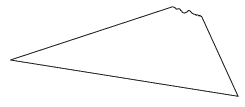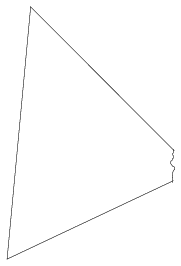 |
Solutions for exercises "C" in February, 2002 |
In this page only the sketch of the solutions are published; in some cases only the final results. To achieve the maximum score in the competition more detailed solutions needed.
C. 660. In how many different ways is it possible to select two fields of a 8x8 chessboard, such that the midpoint of the segment joining the centres of the two fields should also be the centre of a field?
Solution. The fields of the chessboard (i.e. their centres) can be assigned coordinates in the conventional way: let the coordinate axes be the lines formed by the centres of the fields along two perpendicular sides of the board. In this way, the coordinates of all fields are integers betveen 0 and 7, inclusive. The coordinates of the midpoint of the segment connecting the points (a,b) és a (c,d) are \(\displaystyle ({{a+c}\over{2}},{{b+d}\over{2}})\), and these coincide with the coordinates of the centre of a field if and only if a+c and b+d are even, that is, if a and c are of the same parity, and so are b and d.
The point (a,b) may be the centre of any field out of the 64 fields of the chessboard. (a,b) having been selected, the number c can be any of the 4 numbers that have the same parity as a, and independently of that, d can also have 4 different values. In order to make the chosen points different, the number of the possible pairs (c,d) is 1 less than 4.4=16. As the order of the two selected points does not matter, the number of the appropriate number pairs is \(\displaystyle {{1}\over{2}}\cdot64\cdot15=480\).
C. 661. On what condition will the product of a number ending in 9 and a number ending in 7 end in 63?
Solution. Let the numbers in question be A=100x+10a+9, B=100y+10b+7 (a and b are the digits preceding the last digit, x and y are integers). Then AB=100v+10(7a+9b)+63 ends in 63 if and only if 7a+9b=10b+(7a-b) is divisible by 10, that is, if b equals the last digit of 7a. Thus the last two digits of A and B is given by one of the following number pairs: (09;07), (19;77), (29;47), (39;17), (49;87), (59;57), (69;27), (79;97), (89;67), (99;37).
C. 662. The volume of a brick is 8 cm3. If each edge is increased by 1 centimetre, the volume of the new brick will be 27 cm3. What will be the volume if each edge is now increased again by 1 centimetre?
Solution. If a,b,c denote the edges of the cuboid, then abc=8 and (a+1)(b+1)(c+1)=27. By carrying out the multiplications in the second equation, we get abc+(ab+ac+bc)+(a+b+c)+1=27, azaz (ab+ac+bc)+(a+b+c)=18. From the inequality of the geometric and arithmetic means, \(\displaystyle ab+ac+bc\geq3\cdot\root3\of{ab\cdot ac\cdot bc}=3\cdot\root3\of{(abc)^2}=3\cdot\root3\of{64}=12\) and \(\displaystyle a+b+c\geq3\cdot\root3\of{abc}=6\), and therefore 18=(ab+ac+bc)+(a+b+c)\(\displaystyle ge\)12+6=18. Thus there is equality in both cases, hence a=b=c (and ab=ac=bc), that is, a=b=c=2. If each edge is increased by a further 1 centimetre, the volume of the resulting cuboid will be 43=64.
C. 663. A sheet of paper in the shape of an acute triangle has the vertex with the largest angle torn off. On the remaining piece of paper, construct the radius of the circumscribed circle of the triangle.

Suggested by S. Róka, Nyíregyháza
Solution. Construct the midpoint F of the side AB that remained intact. Choose a point A' on the segment AF, so close to F that the intersection of the parallel drawn to the cut side a through the point B' lying on the segment FB at a distance FA' from F, and the parallel drawn to the side b through A' should lie on the sheet of paper. Thus A', B' and the intersection are the vertices of a triangle that is similar to the original triangle.

The circumcentre K' of this small triangle can be constructed. The parallel drawn to B'K' through the point B intersects the ray FK' at the circumcentre K of the original triangle if that point lies on the sheet at all.. As it does not necessarily lie on the sheet, we need to construct a segment equal to BK in some roundabout way. Choose a point P on the sheet, such that the whole triangle PAB should lie on the sheet, and PA should be greater than FB (the half of side AB). On the ray AP, mark the two points whose distances from A are equal to FB' and FB, and on the ray AB, mark the point whose distance from A is K'B'. It follows from the equality of the ratios of the corresponding segments that the parallel drawn to the transversal connecting the endpoints of the segments equal to FB' és K'B' through the endpoint of the segment equal to FB intersects AB at a distance of KB from A. This segment equal to KB does lie entirely on the segment AB, as the length of the longest side of a triangle inscribed in a circle of radius r is at least \(\displaystyle \sqrt{3}\)r">.
C. 664. Determine the distance between the tangents drawn to the parabolas y=x2+1 and x=y2+1 parallel to the line y=x.
Solution. The parabola x=y2+1 is the reflection of the parabola y=x2+1 in the line y=x. Thus the distance of the two tangents is the double of the distance of the contact point of the second parabola from the line y=x.
The slope of the tangent to the parabola y=x2+1 at its point of abscissa a is 2a, and as 2a=1, the coordinates of the contact point are \(\displaystyle ({{1}\over{2}};{{1}\over{4}}+1={{5}\over{4}})\). The distance of this point from the line \(\displaystyle -{{x}\over{\sqrt{2}}}+{{y\over{\sqrt{2}}}}=0\) is \(\displaystyle -{{1/2}\over{\sqrt{2}}}+{{5/4}\over{\sqrt{2}}}={{3\sqrt{2}}\over{8}}\), and therefore the distance between the two tangents is \(\displaystyle 2\cdot{{3\sqrt{2}}\over{8}}={{3\sqrt{2}}\over{4}}\).
